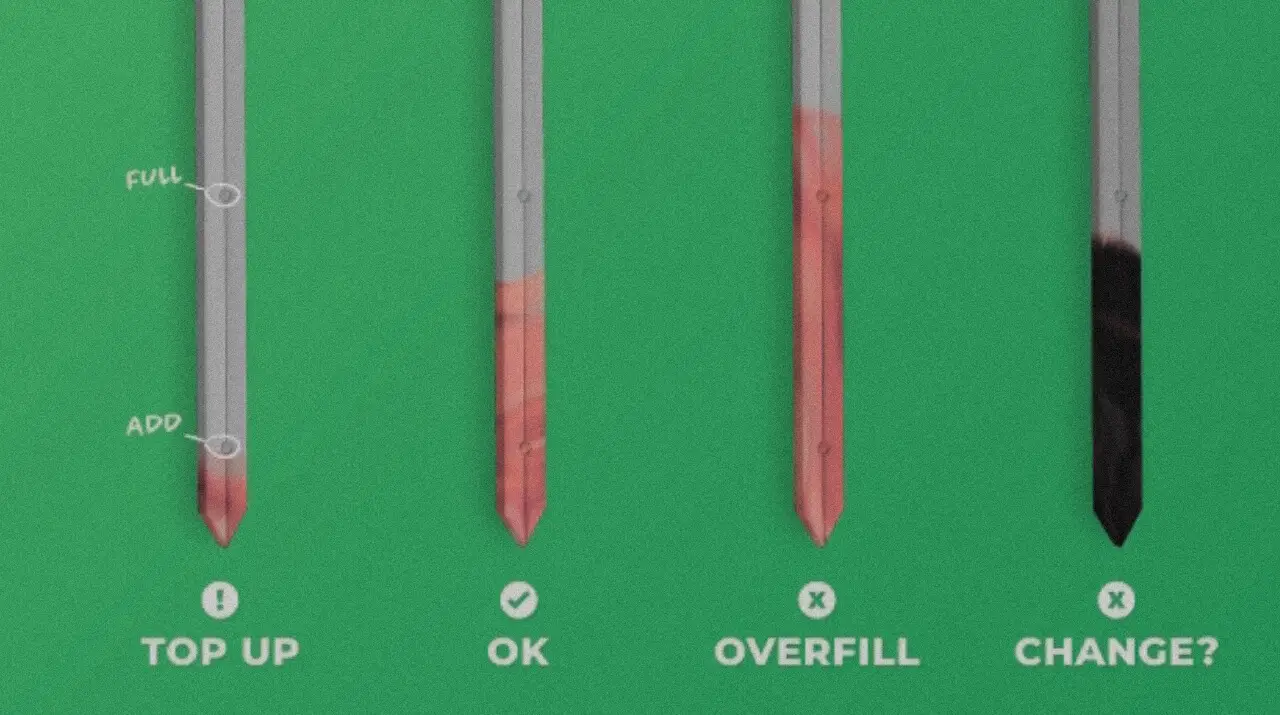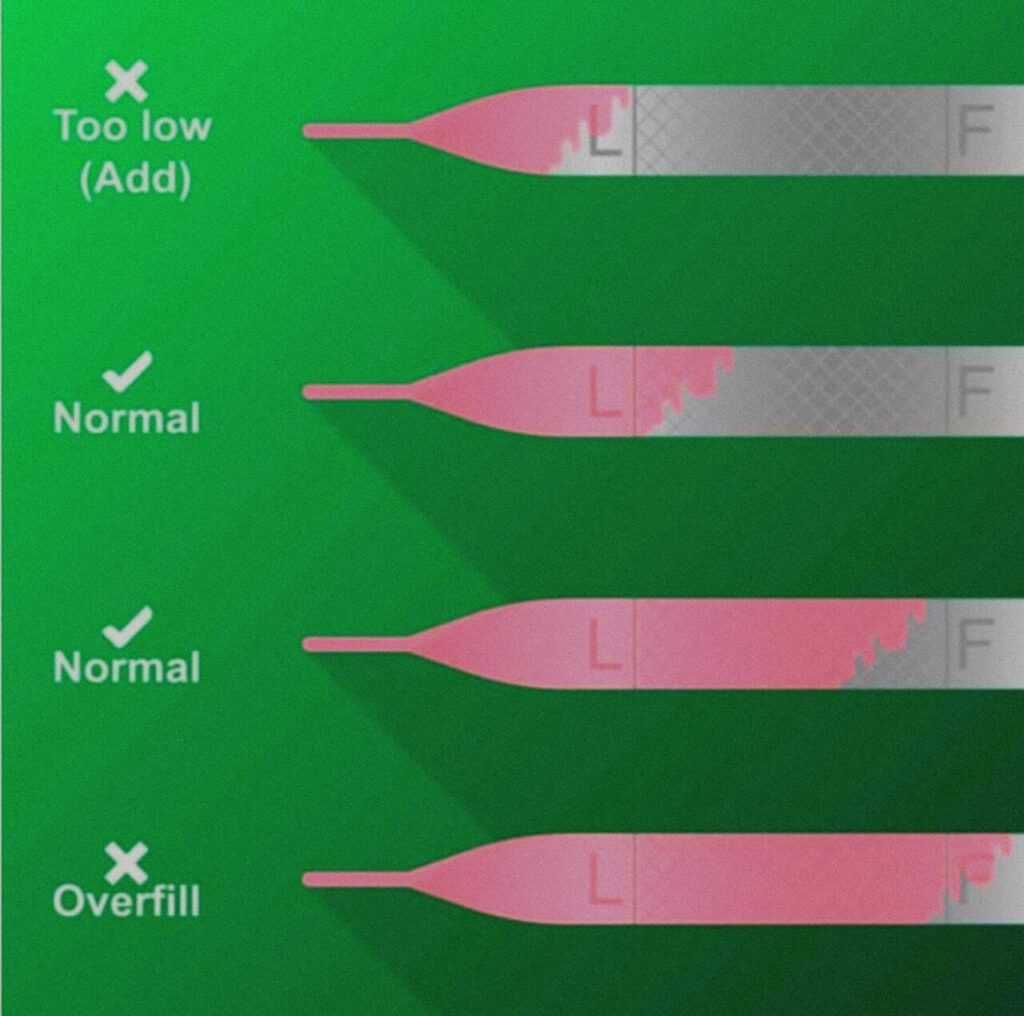As an Amazon Associate, we earn from qualifying purchases. This does not affect the price you pay or the quality of the products you buy. For more information, please read the full affiliate disclosure here.
Note: This article focuses mostly on cars, but you can also implement the same steps for your generator and other engines like tractors, lawnmowers, etc.
Engine oil is essential for the smooth and efficient operation of your car. It lubricates the moving parts of the engine, reduces friction and wear, prevents corrosion, and helps cool the engine. However, too much of a good thing can be bad.
Overfilling engine oil means adding more oil than the recommended level, which can happen by mistake or negligence. This can cause serious problems for your engine and your wallet.
In this article, we will explain the symptoms and consequences of overfilling engine oil and how to fix it.
The Effects of Excess Oil on the Engine Components

Overfilling engine oil can have negative effects on the engine components, as it can interfere with the normal functioning of the oil system. Some of the possible effects are:
1: Oil foaming: When the oil level is too high, the crankshaft can dip into the oil and whip it into a froth. This reduces the oil’s ability to lubricate the engine parts, as air bubbles can reduce the oil pressure and flow. This can lead to increased friction, heat, and wear, and eventually engine failure.
2: Oil leakage: When the oil level is too high, the excess oil can build up pressure in the crankcase and force its way out through the gaskets, seals, or other openings. This can cause oil to leak from the engine and contaminate the environment. It can also reduce the oil level and compromise the lubrication of the engine.
3: Oil combustion: When the oil level is too high, the excess oil can get into the combustion chamber and mix with the fuel-air mixture. This can cause the oil to burn along with the fuel, producing blue smoke from the exhaust. This can also increase oil consumption and emissions and damage the catalytic converter.
4: Spark plug fouling: When the oil level is too high, the excess oil can get into the spark plugs and coat them with oil. This can prevent the spark plugs from igniting the fuel-air mixture properly, resulting in poor combustion and performance. This can also cause the engine to misfire, stall, or run rough.
The Signs of Overfilling Engine Oil
Overfilling engine oil can cause various symptoms that indicate a problem with your engine. Some of the common signs are:
1: Blue exhaust smoke: When the oil level is too high, the excess oil can burn in the combustion chamber and produce blue smoke from the exhaust. This is a sign of oil combustion and increased oil consumption.
2: Burning oil smell: When the oil level is too high, the excess oil can leak from the engine and drip onto the hot parts of the engine or the exhaust system. This can cause a burning oil smell in the cabin or outside the engine. This is a sign of oil leakage and contamination.
3: Oil puddle: When the oil level is too high, the excess oil can leak from the engine and form a puddle under the vehicle or generator. This can be seen after parking the car for a while or not using the generator. It is a sign of oil leakage and loss.
4: High oil pressure: When the oil level is too high, the excess oil can create too much pressure in the oil system and cause the oil pressure gauge to read higher than normal. This can also trigger the oil pressure warning light on the dashboard. This is a sign of oil foaming and reduced lubrication.
5: Engine misfire: When the oil level is too high, the excess oil can foul the spark plugs and prevent them from igniting the fuel-air mixture properly. This can cause the engine to misfire, which means that one or more cylinders are not firing as they should. This can also trigger the check engine light on the dashboard. This is a sign of spark plug fouling and poor combustion.
6: Rough idling: When the oil level is too high, the excess oil can affect the engine’s performance and cause it to idle roughly. This means that the engine is running unevenly and is shaking or vibrating more than usual. This can also affect fuel economy and emissions.
7: Stalling: When the oil level is too high, the excess oil can cause the engine to stall, which means that the engine stops running completely. This can happen when the engine is cold or warm, or when the car is in motion or at a stop. This can also affect the safety and reliability of the vehicle or generator.
8: Fluctuating oil gauge: When the oil level is too high, the excess oil can cause the oil gauge to fluctuate or read inaccurately. This can happen because the oil is foaming or leaking or because the oil sensor is malfunctioning. This can make it hard to monitor the oil level and condition.
9: Overheating: When the oil level is too high, the excess oil can cause the engine to overheat, which means that the engine is running at a higher temperature than normal. This can happen because the oil is not lubricating the engine parts properly or because the oil is burning and creating more heat. This can also trigger the temperature warning light on the dashboard. This is a sign of oil foaming, combustion, and increased wear.
10: Check engine light: When the oil level is too high, the excess oil can cause the check engine light to come on. This can happen because the oil is causing problems with the engine’s performance, emissions, or sensors. This is a sign of a serious issue that needs to be diagnosed and fixed as soon as possible.
The Methods of Resolving the Problem of Overfilling Engine Oil

Overfilling engine oil can be fixed by either draining the excess oil or getting a fresh oil change, depending on the severity of the problem and the experience of the car owner. Some of the possible methods are:
1. Draining the excess oil
This method involves removing some of the oil from the engine until the oil level reaches the correct mark on the dipstick. This can be done by using an oil extractor pump, removing the drain plug, or loosening the oil filter.
This method is suitable for minor cases of overfilling and for car owners who are comfortable with doing it themselves. However, this method can be messy, time-consuming, and risky, as it can damage the engine or the oil system if not done properly. Here are the steps to drain the excess oil:
- Park the car or place the generator on a level surface, and turn off the engine. Wait for the engine to cool down and the oil to settle.
- Open the hood and locate the oil dipstick. Pull it out and wipe it clean with a rag. Insert it back and pull it out again. Check the oil level and note how much oil needs to be drained.
- Choose one of the following methods to drain the excess oil:
- Using an oil extractor pump: This method involves using a device that sucks the oil out of the engine through the dipstick tube. This method is clean and easy, but it can also be expensive and slow. To use this method, follow these steps:
- Connect the oil extractor pump to a power source and attach the suction hose to the dipstick tube. Make sure the hose reaches the bottom of the oil pan.
- Turn on the pump and let it suck the oil out of the engine. Monitor the oil level with the dipstick, and stop the pump when the oil level reaches the correct mark.
- Disconnect the pump and the hose, and dispose of the excess oil properly.
- Removing the drain plug: This method involves removing the plug that seals the bottom of the oil pan and letting the oil drain out. This method is fast and cheap, but it can be dirty and difficult. To use this method, follow these steps:
- Raise the car with a jack and support it with jack stands. Make sure the car is stable and secure.
- Place a drain pan under the oil pan and locate the drain plug. Loosen the drain plug with a wrench and remove it carefully. Be prepared for the oil to gush out.
- Let the oil drain out until the oil level reaches the correct mark on the dipstick. Replace the drain plug and tighten it securely.
- Lower the car and dispose of the excess oil properly.
- Loosening the oil filter: This method involves loosening the oil filter that filters the oil before it enters the engine and letting the oil drain out of the oil filter. This method is moderate and simple, but it can be messy and inaccurate. To use this method, follow these steps:
- Locate the oil filter and loosen it slightly with a wrench or an oil filter wrench. Do not remove it completely.
- Let the oil drain out of the oil filter until the oil level reaches the correct mark on the dipstick. Tighten the oil filter securely.
- Dispose of the excess oil properly.
2. Getting a fresh oil change
This method involves replacing the entire oil and oil filter with new ones. This can be done by taking the car to a professional mechanic or by doing it yourself.
This method is suitable for severe cases of overfilling or for car owners who are not comfortable with draining the excess oil themselves.
However, this method can be costly, wasteful, and unnecessary, as it can discard the good oil along with the bad oil. Here are the steps to get a fresh oil change:
- Park the car on a level surface and turn off the engine. Wait for the engine to cool down and the oil to settle.
- Open the hood and locate the oil dipstick. Pull it out and wipe it clean with a rag. Insert it back and pull it out again. Check the oil level and note how much oil needs to be replaced.
- Choose one of the following methods to get a fresh oil change:
- Taking the car to a mechanic: This method involves taking the car to a professional mechanic who can perform the oil change for you. This method is easy and reliable, but it can be expensive and time-consuming. To use this method, follow these steps:.
- Find a reputable mechanic near you and make an appointment for an oil change. Tell them the reason for the oil change and the amount of oil that needs to be replaced.
- Take the car to the mechanic and let them do the oil change. They will drain the old oil and oil filter and replace them with new ones. They will also check the oil level and condition and adjust it if needed.
- Pay the mechanic and take the car back. Keep the receipt and the warranty for future reference.
- Doing it yourself: This method involves doing the oil change yourself. This method is cheap and fast, but it can be difficult and risky, as it can damage the engine or the oil system if not done properly. To use this method, follow these steps:
- Buy the correct oil type and amount and a new oil filter, according to the owner’s manual or the online guide. You will also need a drain pan, a wrench, an oil filter wrench, a funnel, and some rags.
- Raise the car with a jack and support it with jack stands. Make sure the car is stable and secure.
- Place a drain pan under the oil pan and locate the drain plug. Loosen the drain plug with a wrench and remove it carefully. Be prepared for the oil to gush out.
- Let the oil drain out completely and dispose of it properly. Replace the drain plug and tighten it securely.
- Locate the oil filter and remove it with an oil filter wrench. Be careful not to spill any oil. Dispose of the old oil filter properly.
- Lubricate the gasket of the new oil filter with some oil and install it on the engine. Tighten it by hand or with an oil filter wrench.
- Open the oil filler cap and use a funnel to pour the new oil into the engine. Do not overfill the oil. Check the oil level with the dipstick and adjust it if needed.
- Replace the oil filler cap and lower the car. Start the engine and let it run for a few minutes. Check for any leaks or noises. Turn off the engine and check the oil level and condition again.
How to Prevent Overfilling Engine Oil in the Future

Overfilling engine oil is a common and avoidable mistake that can cause serious problems for your engine and your wallet. To prevent overfilling engine oil in the future, you should follow these tips:
1. Read the owner’s manual.
The owner’s manual is the best source of information on how to maintain your car, including how to check and change the oil. It will tell you the correct oil type and amount, the oil change schedule, and the oil level indicators. You should read the owner’s manual carefully and follow its instructions.
2. Use the correct oil type and amount.
The type and amount of oil are important factors that affect the performance and longevity of your engine. You should use the oil type and amount that are recommended by the manufacturer or the mechanic. You should not use a different oil type or amount without consulting them first.
3. Check the oil level regularly.
The oil level is an indicator of the oil’s condition and the engine’s health. You should check the oil level regularly, at least once a month or before a long trip. You should use the dipstick to check the oil level and make sure it is between the minimum and maximum marks. You should also check the oil’s color and consistency and look for any signs of contamination or degradation.
4. Follow the oil change schedule.
The oil change schedule is a guideline on how often you should change the oil and oil filter. It is based on the mileage, the driving conditions, and the oil type. You should follow the oil change schedule to keep the oil fresh and clean and to prevent the oil from breaking down or becoming contaminated. You should also keep a record of the oil changes and the receipts.
Final Words
Overfilling engine oil is a mistake that can have serious consequences for your engine and your wallet. It can cause the oil to foam, leak, combust, or foul the spark plugs, resulting in poor lubrication and performance for the engine.
It can also cause various symptoms that indicate a problem, such as blue exhaust smoke, burning oil smell, oil puddle, high oil pressure, engine misfire, rough idling, stalling, fluctuating oil gauge, overheating, and checking the engine light.
Overfilling engine oil can be fixed by either draining the excess oil or getting a fresh oil change, depending on the severity of the problem and the experience of the car owner.
However, the best way to deal with overfilling engine oil is to prevent it from happening in the first place. You can do this by reading the owner’s manual, using the correct oil type and amount, checking the oil level regularly, and following the oil change schedule.
We hope this article has helped you understand the symptoms and consequences of overfilling engine oil and how to fix it. If you have any questions or comments, please feel free to contact us.
Share![What Is Generac Service Schedule A? [Answered] What Is Generac Service Schedule A? [Answered],](https://generatorhacks.com.ng/storage/2023/08/What-Is-Generac-Service-Schedule-A_-Answered-1024x576.jpg)

